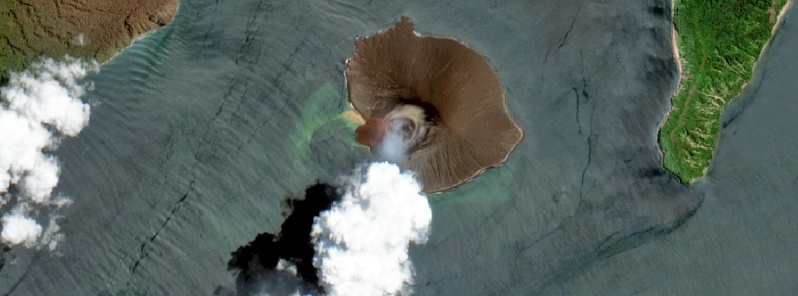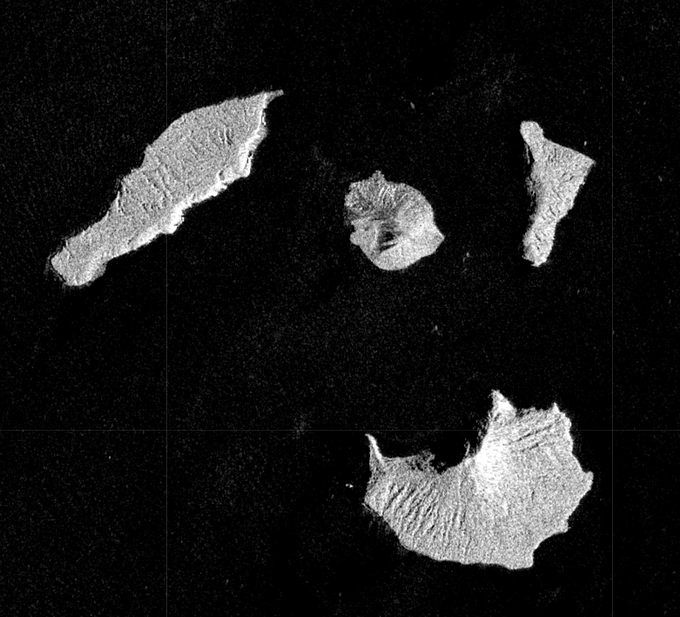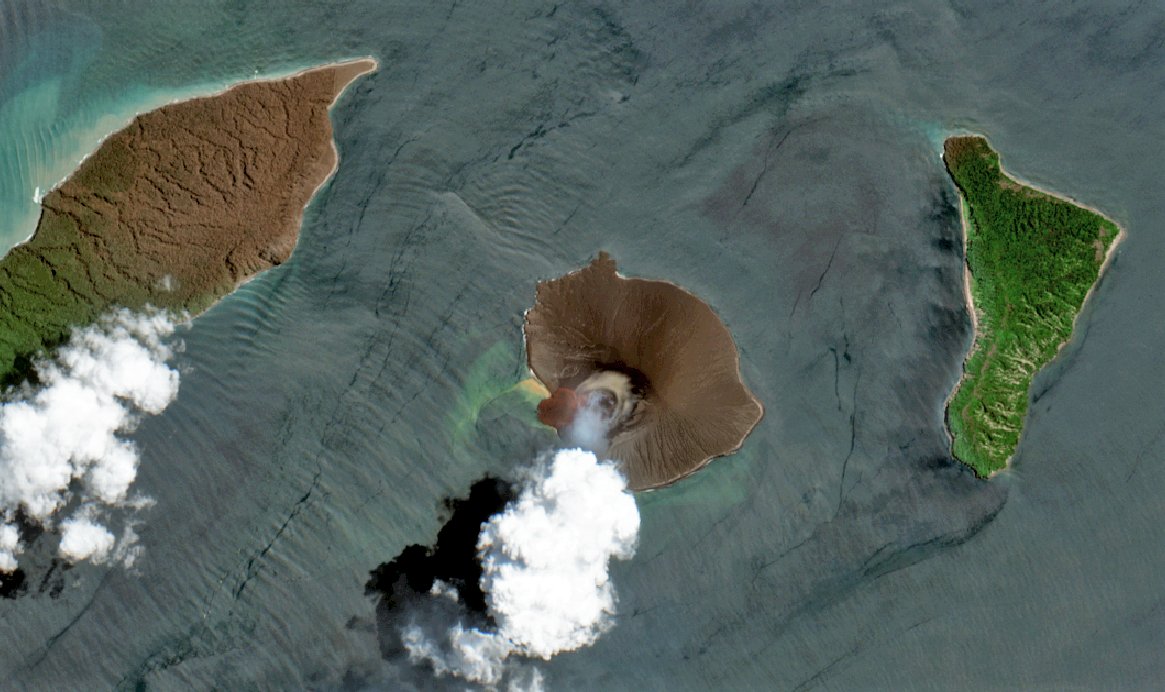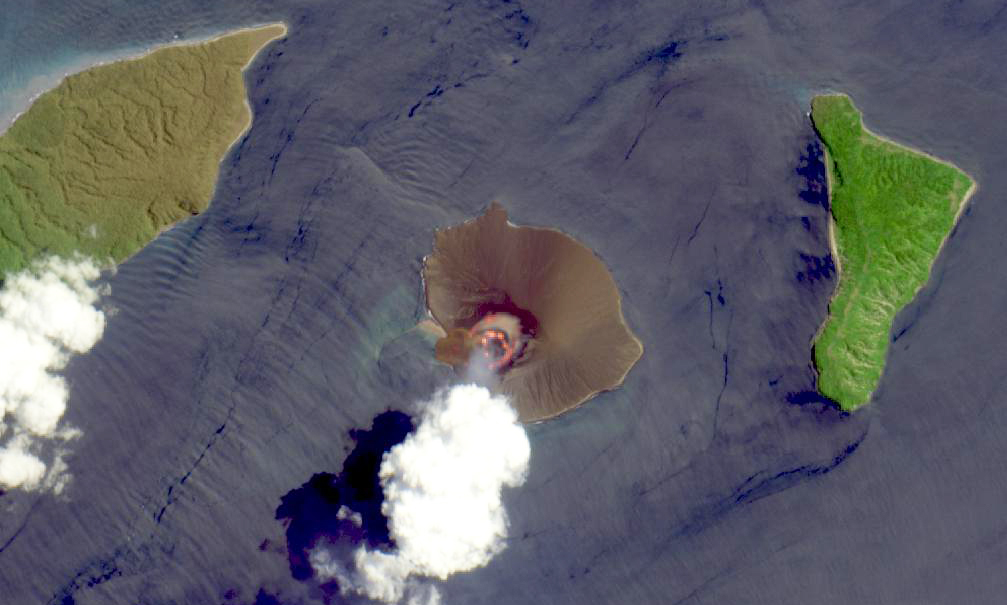Clear sky satellite imagery of Anak Krakatau volcano after strong eruption on April 10

The European Sentinel-2 satellite acquired first clear sky images of Indonesian Anak Krakatau volcano after strong eruption on April 11, 2020. The activity level of the volcano remains at 2 (Waspada) — residents and tourists are not allowed within 2 km (1.2 miles) around the crater. The Aviation Color Code remains Orange.
The volcano experienced an increase in volcanic activity from June 18, 2018, followed by a series of eruptions from September 2018 to February 2019, including a flank collapse in December 2018 which generated a devastating 1.4 m (4.6 feet) high tsunami in which at least 430 people lost their lives — 7 200 people were injured and 1 778 homes destroyed.
The last notable eruptions occurred on April 10, 2020, with volcanic ash reaching 14.3 km (47 000 feet) above sea level (Darwin VAAC), and on April 13.

Small-scale eruptions were also recorded on April 16 at 07:47 UTC — max amplitude 25 mm and max duration 25 seconds; on April 17 and 00:49 UTC — max amplitude 40 mm and max duration 50 seconds, the best-estimate ash-cloud top was around 207 m (662 feet) above sea level; and on April 17 at 10:32 UTC — max amplitude 40 mm and duration 27 seconds.
Sentinel-2 images acquired on April 17 confirmed changes seen on the radar image acquired by Sentinel-1 on April 15.
I spy with my microwave eye. Nice #Sentinel1 radar overpass of #AnakKrakatau on April 15 penetrates the #volcanic plume & clouds to reveal the April 10 #eruption products. Looks like a lava flow and/or other deposits have smothered the pre-existing crater lakes. @CopernicusEMS pic.twitter.com/GB0lzABnZQ
— Simon Carn (@simoncarn) April 16, 2020


Image credit: Copernicus EU/Sentinel-1, Simon Carn. Acquired April 15, 2020
In addition to the hotspots, images show the new morphology of the crater area.
The pre-existing crater lakes appear to have been partially filled by lava and other deposits. Lava delta, still warm, protrudes on the west coast of the island, Bernard Duyck of Earth of Fire noted.


Image courtesy Copernicus EU/Sentinel-2, Antonio Vecoli. Acquired April 17, 2020 at 03:05 UTC


Image courtesy Copernicus EU/Sentinel-2, Antonio Vecoli. Acquired April 17, 2020 at 03:05 UTC
This amazing HQ drone video of the volcano was captured on January 10 and 11, 2019 — less than a month after major eruption and flank collapse on December 22, 2018.


Geological summary
The renowned volcano Krakatau (frequently misstated as Krakatoa) lies in the Sunda Strait between Java and Sumatra. The collapse of the ancestral Krakatau edifice, perhaps in 416 CE, formed a 7-km-wide (4.3 miles) caldera.
Remnants of this ancestral volcano are preserved in Verlaten and Lang Islands; subsequently Rakata, Danan and Perbuwatan volcanoes were formed, coalescing to create the pre-1883 Krakatau Island. Caldera collapse during the catastrophic 1883 eruption destroyed Danan and Perbuwatan volcanoes and left only a remnant of Rakata volcano.
This eruption, the 2nd largest in Indonesia during historical time, caused more than 36 000 fatalities, most as a result of devastating tsunamis that swept the adjacent coastlines of Sumatra and Java. Pyroclastic surges traveled 40 km (25 miles) across the Sunda Strait and reached the Sumatra coast.
After a quiescence of less than a half-century, the post-collapse cone of Anak Krakatau (Child of Krakatau) was constructed within the 1883 caldera at a point between the former cones of Danan and Perbuwatan. Anak Krakatau has been the site of frequent eruptions since 1927. (GVP)
Featured image: Anak Krakatau at 03:05 UTC on April 17, 2020. Credit: Copernicus EU/Sentinel-2, Antonio Vecoli

Commenting rules and guidelines
We value the thoughts and opinions of our readers and welcome healthy discussions on our website. In order to maintain a respectful and positive community, we ask that all commenters follow these rules:
We reserve the right to remove any comments that violate these rules. By commenting on our website, you agree to abide by these guidelines. Thank you for helping to create a positive and welcoming environment for all.